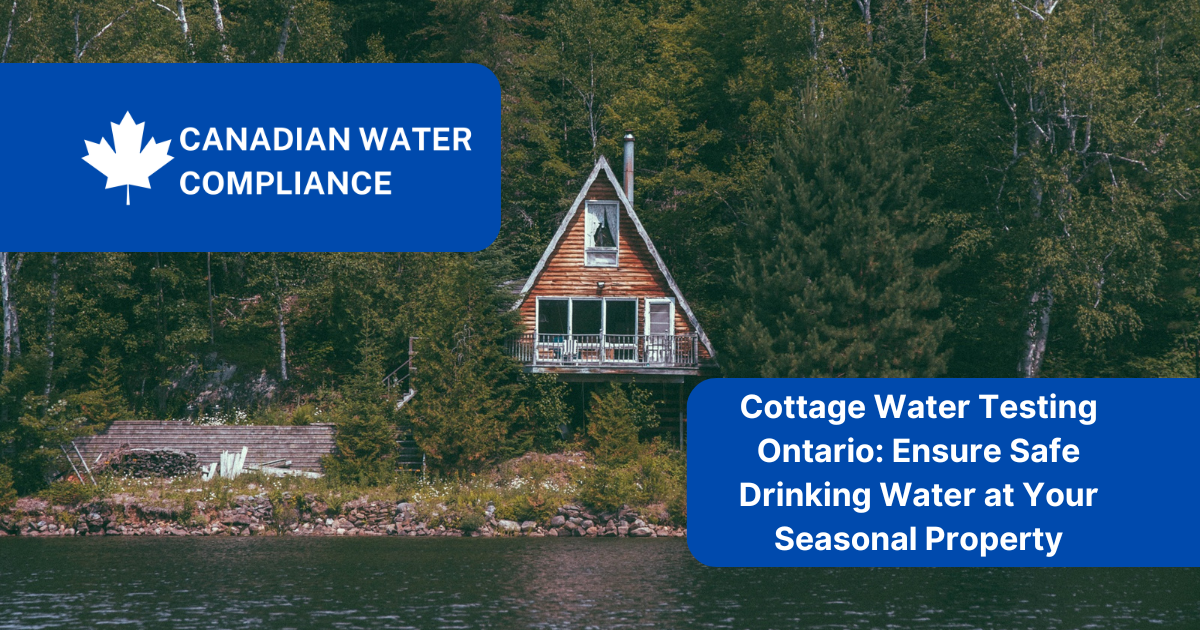
Written By: Canadian Water Compliance | On
When spring and summer return, so do Ontario's cottage communities. Whether you're opening the family cabin for the long weekend or managing a short-term rental property, one essential question should be at the top of your checklist: Is the water safe to use?
Seasonal and rural properties often rely on wells, surface water, or older infrastructure that isn’t tested as frequently as municipal systems. This can leave occupants vulnerable to bacteria, nitrates, heavy metals, and other dangerous contaminants. Without proper testing and treatment, cottage water can pose serious health risks—especially to children, the elderly, and those with compromised immune systems.
Unlike municipal water systems, which are monitored and treated continuously, private water sources like wells and lakes are unregulated and vulnerable to contamination from surface runoff, animal activity, failing septic systems, and seasonal changes like spring thaw.
During the spring, melting snow and rain can carry bacteria, fertilizers, and other pollutants into groundwater and surface water supplies. Shallow dug wells and shoreline intakes are especially prone to contamination during this time.
Common contaminants include:
E. coli and Total Coliform – Indicators of fecal contamination and potential pathogens.
Nitrates – Common from fertilizer or septic system runoff, harmful to infants.
Lead and Heavy Metals – Leached from plumbing in older or seasonal infrastructure.
Giardia and Cryptosporidium – Parasites often found in untreated lake or river water.
In Ontario, private water systems are not regulated under the Safe Drinking Water Act. This means the responsibility for water quality falls on the property owner.
Ontario Public Health Units recommend testing for E. coli and total coliform bacteria at least three times per year: once when the system is first opened in spring, once mid-season, and again before closing the property for winter.
Additional testing may be necessary if:
You notice a change in taste, smell, or appearance
Heavy rainfall or flooding has occurred
The system has been inactive for long periods
You're renting the property to others
Beyond bacterial testing, it’s advisable to conduct a full chemical analysis every 2–3 years, especially for properties near agricultural areas or with older plumbing.
Drinking or bathing in contaminated water can lead to:
Gastrointestinal illness (nausea, diarrhea, vomiting)
Parasitic infections
Skin and eye irritation
Long-term health effects from heavy metal exposure
Property owners who rent out their cottages may also be held liable if waterborne illness occurs due to negligence. This could result in legal action, bad reviews, and loss of revenue.
Ensure your seasonal property is protected by following these essential steps:
Test Early and Often – Schedule certified water testing when opening and throughout the season.
Flush the System – Stagnant water sitting in pipes or tanks all winter can breed bacteria. Flush thoroughly before use.
Install Treatment Solutions – UV disinfection, filtration, or chlorination systems may be needed depending on your test results.
Keep Good Records – Maintain testing logs and system maintenance records to track changes and support inspections.
Use Certified Technicians – For accurate sampling and proper interpretation of results, partner with a licensed water testing provider.
At Canadian Water Compliance, we specialize in helping cottage and seasonal property owners across Ontario keep their water safe, clean, and compliant. Our services include:
Certified water sampling for bacteria, metals, and chemical parameters
Fast lab analysis with easy-to-read reports
Ongoing monitoring and re-testing for rentals or shared-use properties
Guidance on treatment system selection and maintenance
Whether you're reopening the family cottage or prepping your property for Airbnb guests, we’ll help ensure your water meets the highest safety standards.
📞 Book your spring water testing today and enjoy peace of mind all season long.